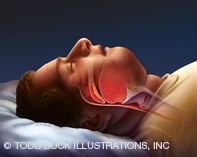Peer Reviewed
Feature Article Respiratory medicine
Obstructive sleep apnoea in adults: identifying risk factors and tailoring therapy
Abstract
Obstructive sleep apnoea is increasingly being recognised as a significant health problem. Diagnosis is based on clinical assessment and objective testing and there are now several treatment options that can be tailored to each affected patient.
Key Points
- Left untreated, obstructive sleep apnoea (OSA) may contribute to several health-related adverse outcomes.
- Diagnosis is based on clinical history, physical examination and objective findings during laboratory polysomnography or on a portable device.
- Behavioural modification is indicated in most patients with OSA. Weight loss should be attempted in overweight or obese patients.
- Positive airway pressure (PAP) therapy remains the first-line treatment, particularly in moderate to severe OSA.
- Mandibular advancement splints are an alternative first-line treatment, particularly in mild to moderate OSA or when PAP therapy is refused or fails.
- Surgery is considered first-line treatment only when there is an identifiable cause for OSA that can be surgically corrected. It is otherwise reserved for selected patients who have failed or are not suitable for PAP or therapy with an oral device.
- Optimal outcomes require skilled personnel, coupled with education and monitoring within a clinical context.
Purchase the PDF version of this article
Already a subscriber? Login here.

